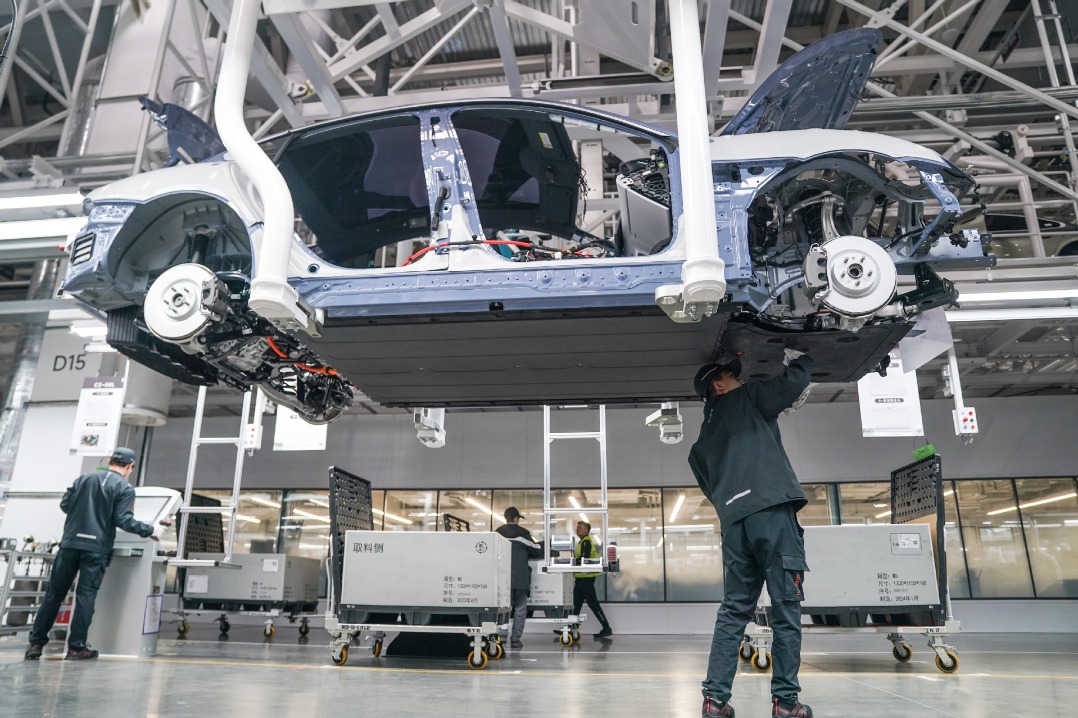Technology innovation key to steady economic growth
By Liu Xiaoguang | China Daily | Updated: 2024-04-22 09:40

After China's GDP grew 5.2 percent last year and 5.3 percent year-on-year in the first quarter, it is expected to continue to expand at a relatively high rate over the long run. Endowed with abundant resources and a huge domestic market, the country is well-positioned to further promote institutional and technological innovation, as well as high-standard opening-up, thereby injecting fresh impetus into the economy and embarking on a road of sustainable development.
Policy adjustments
China began to optimize its economic structure and improve the quality of growth in 2012. The country expects to shift the main driving force behind GDP growth from expanding investment to promoting technological development. The COVID-19 pandemic has also taken a toll on the Chinese economy. Luckily, after years of policy adjustments, the economic slowdown in China is about to end and its economy is expected to grow steadily in the coming years.
The country has carried out a series of market-oriented reforms on its pricing system, property rights, labor market, capital market and commercial property sector, aiming to reach a relative balance between supply and demand, and laying solid institutional foundations for economic growth. It has also properly adjusted the industrial structure and market access rules, which has significantly alleviated the longstanding challenges in production.
Meanwhile, China has improved its income distribution, especially by addressing gaps in household incomes, which has reduced income inequalities between urban and rural workers, and further advanced consumption upgrading. Eyeing all-round development, the country has also continuously optimized public services such as education, healthcare, housing and eldercare.
As for the development of emerging technologies, China has remained ahead of the curve. The country has been a member of the Patent Cooperation Treaty for 30 years and, since 2019, the number of its PCT international patent applications has ranked first in the world for four consecutive years.
Under the authorities' firm support, enterprises and research institutions have made significant achievements in sectors such as internet, biotech and new materials, with relevant capital markets and industrial chains gradually taking shape in the country.
In addition, a variety of monetary and fiscal policies have been issued to reduce burdens on enterprises and ensure a favorable business environment. The country has implemented inclusive tax exemption and reduction policies for small and micro enterprises, while further deepening value-added tax reform in real sectors including manufacturing, construction and transportation.
China has also promoted the development of the securities market, including the science and technology innovation board — the STAR Market. When it comes to indirect financing, the country has improved the lending capacity of commercial banks.
Promising future
China has set an economic growth target of around 5 percent for this year. Barring unforeseen circumstances, the Chinese economy is very likely to achieve an average annual growth rate of more than 4.8 percent over the next 15 years, with the total GDP doubled and per capita GDP and gross national income reaching levels of a moderately developed country.
Endowed with abundant factors of production, China has built the most comprehensive and largest industrial system in the world and has huge potential to further boost productivity. Among more than 500 major industrial products, China ranks first in the world in terms of the output of more than 220 products.
China is largely self-sufficient in agricultural products and natural resources. It is able to efficiently utilize various human and material resources to cope with economic problems and natural disasters, thus ensuring the sustainable development of the economy.
The country also possesses an extremely large domestic market and has realized the proper division of labor. It not only has the world's second-largest population of 1.4 billion, but also has the world's largest middle-income population of 400 million.
In addition, with China further enhancing its overall strength and improving people's livelihoods, both domestic demand and total retail sales of consumer goods will continue to increase. Therefore, even if there is a sharp drop in external demand, the country will still be able to safeguard its economy by promoting domestic circulation.
Under the impact of the COVID-19 pandemic, many industrial and market entities have stepped up efforts to develop new business models, such as livestream shopping and employee sharing, aimed at expanding to new sales channels, improving productivity and lowering operating costs. These new models will significantly contribute to the vigor and vitality of China's business performance in the long run.
According to this year's Government Work Report, China will continue to attract more foreign direct investment by completely removing restrictions on foreign investment access in the manufacturing sector, and relaxing market access for services such as telecommunications and medical care. It will be more convenient for foreigners to work, study and travel in China, and reform and innovation in the free trade zones will be further advanced, so as to promote high-standard opening-up in all respects.
Meanwhile, with competitive products continuously exported to other economies, China has turned into a world manufacturing center. The proportion of high-tech products and large equipment among exported goods is increasing. However, there is still a gap between China and Western countries in terms of core technologies, which requires further efforts to promote technological and scientific innovation.
Moreover, the value-added of China's primary and tertiary industries accounted for 7.1 percent and 54.6 percent of the GDP last year, respectively, while in most developed countries, the corresponding figures are less than 5 percent and more than 60 percent.
In order to further narrow the gaps, China needs to ensure full employment and promote the transfer of agricultural labor to nonagricultural industries, especially the tertiary sector. As a result, the country's industrial structure will be more modernized, thereby creating better conditions for further economic growth.
The writer is a professor at the National Academy of Development and Strategy, Renmin University of China.
The views don't necessarily reflect those of China Daily.






















